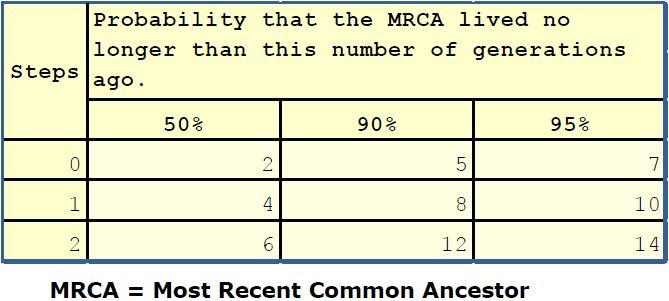DNA testing
The Direct Paternal Line
Your direct paternal lineage is the line that follows your father’s paternal ancestry. This line consists entirely of men. Your Y-Chromosome DNA (Y-DNA) can trace your father, his father, his father’s father, and so forth. It offers a clear path from you to a known, or likely, direct paternal ancestor.
Note that you and your matches may share ancestors on other parts of your family tree; however, those matches are a coincidence.
Matching for Genealogy
Your Y-DNA may help you find genetic cousins along your direct paternal line. For Y-DNA37 results, we report your results for STR markers. STR marker values change slowly from one generation to the next resulting in distinctive sets of results. We compare your set of results to those of other men in our database. The range of possible generations before you share a common ancestor with a match is wide. Your Y-DNA37 exact matches (0 Steps) may be recent, but they may also be hundreds of years in the past. Your matches that have one marker difference (1 Step) may be even more distantly related. We show this in the table below.
The wide range in the test results does not prevent those results from being useful. You can use this clear paternal line to provide evidence to support a relationship. You first trace two or more male lineage descendants of a single man utilizing traditional genealogy research. The descendants then test their Y-DNA. If they are exact matches, it is evidence that supports the relationship. Not matching usually disproves the relationship. Planned comparisons are the best choice. However, you can still find your common ancestor with matches. To do so, use your known paternal genealogy. For each match, look first for a shared surname if you come from a culture where surnames have followed paternal lines. Then look for common geographic locations on the direct paternal line. Work through each of your ancestors on this line as well as their sons, their sons’ sons, and so forth.
The Science of Your Direct Paternal Line
Your Y-Chromosome is a sex chromosome. Sex chromosomes carry the genetic code that makes each of us male or female. All people inherit two sex chromosomes. One comes from their mother and the other from their father. You and other men receive a Y-Chromosome from your father and an X-Chromosome from your mother. Men and only men inherit their father’s Y-Chromosome. Thus, it follows the same path of inheritance as your direct paternal line.
STR markers are places where your genetic code has a variable number of repeated parts. We report your STR marker results as the measured number of repeats for each marker. In the example below, the marker DYS393 has 12 repeats.

Your Ancestral Origins
Our Y-DNA marks the path from our direct paternal ancestors in Africa to their locations in historic times. Your ancestors carried their Y-DNA line on their travels. The current geography of your line shows the path of this journey. Your Y-DNA37 results use two ways to explore your paternal origins. The first method uses your main (backbone) branch on the paternal tree. This is your Y-DNA haplogroup. Scientists study the history of populations across geography and time using Y-DNA. They use both the frequencies of each branch in modern populations and samples from ancient burial sites. With these, they are able to tell us much about the story for each branch. This traces back hundreds, thousands, or even tens of thousands of years. Your branch on the tree tells you where your paternal ancestors are present today and about their likely migration paths. We review what scientists know about your Y-DNA Haplogroup on the Y-DNA – Haplogroup & SNPs page of your myFTDNA account. The second method uses your haplogroup with your STR marker results. We use these to match you to others in our database. These matches are more likely to share your line in historic times. Country frequencies thus reflect your ancestors’ recent history. Both the Y-DNA – Haplogroup Origins and the Y-DNA – Ancestral Origins pages show this information.
